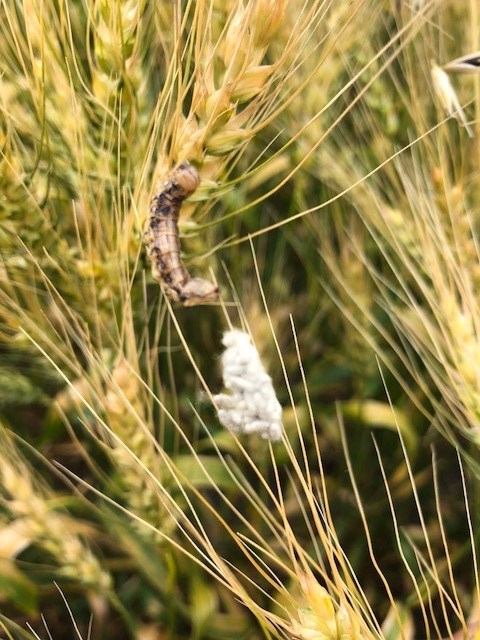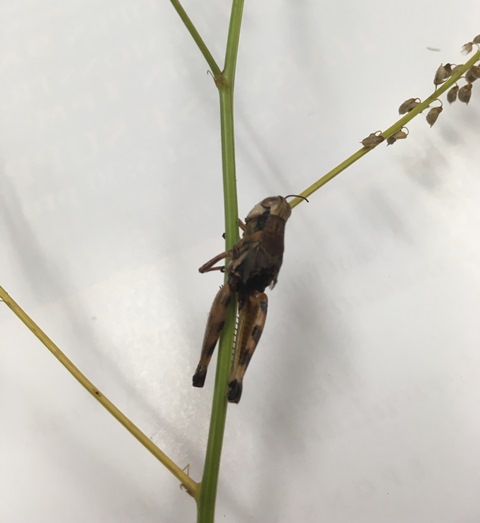Manitoba Insect & Disease Update
Issue 10: August 1, 2018
Summary
Diseases: New clubroot cases have been confirmed in the Rural Municipalities of Lorne and Dufferin.
Insects: Scouting for bertha armyworm continues. There are a few reports of insecticide applications (near Melita, Deerwood, Holland, and Rossendale).
Spider mites are being noticed in some soybean fields. In most cases there are heavy edge effects, and no reports of economic levels.
Grasshopper population are variable. Some are reporting low levels, other are watching for potential movement from areas bordering fields. If ditch vegetation is cut it can force grasshoppers into fields. Watch for grasshopper movement if ditch area have a lot of grasshoppers and are being cut.
Bertha Armyworm
Some economical populations have been reported from the Southwest and Central regions.
Length of larval stages: How long bertha armyworm remains in the larval stage depends on the temperature. Lab studies determined that at a constant temperature of 20C it took 30 days to complete the 6 larval stages, at 24C it took 21 days, and at 28C it took 18 days (The Canadian Entomologist. 1976: 1339-1344). So with the fluctuating temperatures we get in late-July and August I would expect it to take somewhere around 3 weeks for the larvae to pass through their 6 larval stages. The last larval stage (instar 6) lasts the longest, lasting for 8 days at 24C. However, when they get into the later part of this stage they are not feeding and getting ready to transform into a pupa.
Preharvest Interval: A reminder that should economic levels of bertha armyworm be detected in podding canola, preharvest intervals needs to considered. The preharvest interval (phi) is the number of days until swathing, or direct combining. So some insecticides like cypermethrin (30 day phi) and chlorpyrifos (21 day phi) will not be options in some situations. There are a few insecticides with a 7 day phi, but only 1 option (Coragen) once you get within a week of swathing.
Clusters on heads of cereals
A few people have enquired recently about what the "egg-like clusters" are on the heads of some cereal crops.

Figure 1. Pupal cases on wheat head
Photo by Kathy-Jo Toews - Richardson Pioneer
These are pupal cases of a parasitoid of caterpillars called Cotesia (Braconidae). There are many species of Cotesia, which can be hard to tell apart. Often Cotesia wasps will lay many eggs (20 to 60) into a caterpillar. About 2 or 3 weeks later the wasp larvae emerge from the caterpillar and spin their cocoons on or near the caterpillar, which dies when the wasp larvae emerge. Eventually the adult parasitic wasps will emerge from these cocoons and be looking for more caterpillars to lay batches of eggs into.
Insect Monitoring Programs
Grasshopper Survey: A reminder for those participating in the grasshopper survey, that counts are done during August, when the majority of grasshoppers are in the adult stage. Even if grasshopper levels are low in your area, this is valuable data for the survey. So don't not do counts in a region because grasshopper levels are low. The purpose of the survey is to map what average grasshopper levels are like in a region, so waiting until a high level is encountered to do an assessment would bias the data.
Agronomists and farmers who would also be interested in estimating grasshopper numbers in or around the fields they are in and have this information included in the survey are encouraged to see the survey protocol for more details of the survey and where to send data. Estimates of grasshopper levels can be collected during regular farm visits.
"Estimates" of grasshopper populations is stressed as it will not be possible to accurately count grasshoppers along a field edge or ditch area as they will be moving around as you get near the area of the count. But estimate of what is present gives us some idea of the relative numbers that are present in different areas.
Data from the survey, along with weather data during the egg laying period of the grasshoppers, is used to produce a forecast for 2018.
The protocol and data sheet for the grasshopper survey is at: http://www.gov.mb.ca/agriculture/crops/insects/mb-grasshopper-survey.html
"Estimates" of grasshopper populations is stressed as it will not be possible to accurately count grasshoppers along a field edge or ditch area as they will be moving around as you get near the area of the count. But estimate of what is present gives us some idea of the relative numbers that are present in different areas.
Data from the survey, along with weather data during the egg laying period of the grasshoppers, is used to produce a forecast for 2018.
The protocol and data sheet for the grasshopper survey is at: http://www.gov.mb.ca/agriculture/crops/insects/mb-grasshopper-survey.html
Insect Identification Quiz
While scouting crops you notice dead grasshoppers that died clinging to the upper parts of plants in the field. What is causing this to happen?

Photo by Nicole Blyth - Portage Co-op
Answer: These dead grasshoppers are infected with a fungus, which alters their behaviour so they die at the top of a plant. This will make it easier for spores to spread. A few people have reported observing this recently.

Photo by Nicole Blyth - Portage Co-op
Answer: These dead grasshoppers are infected with a fungus, which alters their behaviour so they die at the top of a plant. This will make it easier for spores to spread. A few people have reported observing this recently.
Unlike most other insect pathogens that must be ingested to initiate disease, fungi generally invade insects through the external cuticle. A common fungus that is pathogenic to grasshoppers is the complex known as Entomophaga grylli, which is likely what caused the death of the grasshopper in this photo. There are other fungi such as Beauveria bassiana and Metarhizium anisopliae that can also kill grasshoppers. Research in Alberta has shown that Metarhizium anisopliae has the potential to be used as an effective and selective insecticide for grasshopper management.
----------------------------------------------------------------------------------------------------------------------
Compiled by:
John Gavloski, Entomologist Holly Derksen, Field Crop Pathologist
Manitoba Agriculture Manitoba Agriculture
Phone: (204) 750-0594 Phone: (204) 750-4248
To report observations on insects or plant pathogens that may be of interest or importance to farmers and agronomists in Manitoba, please send messages to the above contacts.
To be placed on an E-mail list so you will be notified immediately when new Manitoba Insect and Disease Updates are posted, please contact John Gavloski at the address or numbers listed above.
